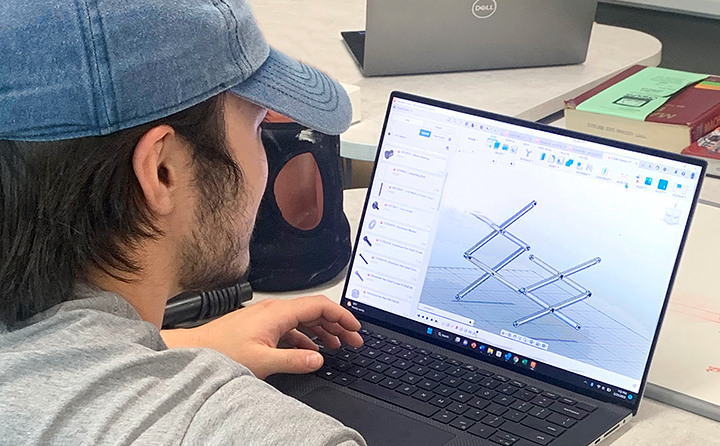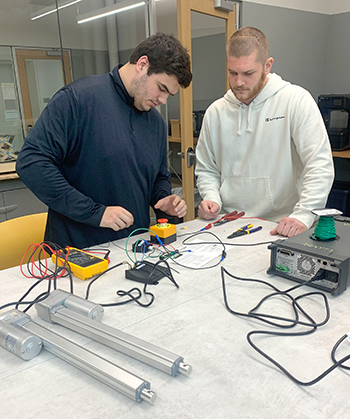From idea to ingenuity to invention, engineering students are partnering with community members to develop a new sit-to-stand walker that can boost mobility for individuals needing accommodation.

The initiative is an interdisciplinary collaboration between engineering and communication sciences and disorders.
"When I learned I was teaching this year's engineering capstone course, I knew I wanted to do a community-involved project focused on assistive and adaptive technology," said associate professor of engineering Dr. Jeff Dusek.
"Professor Christie Needham, who is clinic director for the BW Speech Clinic, and I came up with a collaboration that would unite my students with members of their Way with Words group, which consists of individuals recovering from a stroke who receive services at the BW Speech Clinic.
"Working with real users is essential to good engineering design. This is especially true in the assistive technology field where users have incredible expertise into the use of adaptive devices," noted Dusek.
"The
design
requirements
for
the
sit-to-stand
walker
prototype
came
directly
from
conversations
the
students
had
with
Way
with
Words
users,
their
partners
and
personal
care
assistants,"
he
went
on
to
say.
"The
student
team
met
with
users
throughout
the
fall
semester
to
present
ideas,
co-design
prototype
solutions
and
discuss
ways
to
improve
the
model.
"Because
mobility
limitations
are
highly
individualized,
it
can
be
challenging
to
develop
universal
solutions
with
a
broad
customer
base.
The
economics
are
further
complicated
by
the
role
of
insurance
providers
and
the
income
inequality
of
individuals
needing
such
a
device,"
he
said.
Cooper Harestad, a senior engineering student from Vandalia, Ohio, was one of the students in the capstone class. He described the initial and ongoing brainstorming sessions for the sit-to-stand walker as being rewarding opportunities for the students to apply their technical, creative and problem-solving skills to a real-world challenge.

"Our prototype is a walker that can assist users in standing up from a seated position, which is important in helping individuals maintain independence wherever they go. I love the personal aspect of this project because we gain a connection with the users. It is wonderful to see how happy our walker design makes them," remarked Harestad.
Drew Levis agrees. The senior engineering major from Elyria, Ohio, believes the opportunity has given him experience in how companies approach product development. He went on to say that "working with the community on this project has been super fulfilling in knowing this walker could change the lives of people."
Needham, who sees student interaction with community clients daily through the BW Speech Clinic, believes connecting students to real-world learning experiences and people is essential to professional growth.
"We are preparing students to work in careers where they will be reliant on others for information and solutions. By practicing these skills in the education setting, students can graduate ready to work in diverse and changing workplaces," she explained. "By collaborating with individuals in the community and learning to listen, students form relationships. They start to see problems as opportunities. This enables their work to take on new purpose."
According
to
Dusek,
BW's
engineering
major
provides
outstanding
learning
opportunities.
The
broad-based
program,
he
said,
provides
flexibility
that
enables
students
to
pursue
an
area
of
interest
and
gain
valuable
career-ready
skills.
"Because
we
are
a
small
program,
our
curriculum
can
be
highly
responsive
to
the
needs
of
both
our
students
and
industry
employers.
We
have
evolved
our
curriculum
to
better
support
students
with
their
transition
from
high
school
to
college.
The
department
also
relies
on
the
feedback
from
our
exceptional
Engineering
Advisory
Board,
which
consists
of
working
professionals
in
the
field,
to
make
sure
our
graduates
are
career-ready,"
emphasized
Dusek.
Dusek went on to say that BW engineering faculty offer highly individualized support to students. "Our class sizes are small, which enables multiple opportunities for hands-on learning and plentiful individualized instructor feedback. Our engineering faculty is passionate about providing the best preparation possible to our students."
Though it is still in development, the sit-to-stand walker offers multiple benefits. It utilizes lifting mechanisms to provide an upward force to assist users while standing up. The upward force, resulting from actuators, is a substitution for the assistance provided by another person (which most often occurs when a standing person provides an arm to help lift a mobility-challenged individual out of their seat).